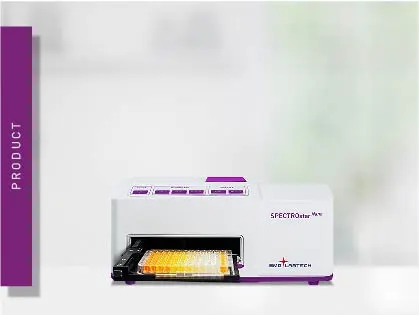
SPECTROstar Nano
Absorbance plate reader with cuvette port
DNA contains all the information for human life. Thus, it´s not surprising, that its relevance increased extensively since its discovery over the past decades. Various methods, from low- to high-throughput, rely on the application of accurate nucleic acid quantities. In this context, the choice of method is very relevant and depends on the intended downstream analysis.
 Dr Ann-Cathrin Volz
Dr Ann-Cathrin Volz
The widespread use of next-generation sequencing and other high-throughput approaches as well as studies on transcription regulation and DNA repair emphasize more than ever the need for reliable and accurate sample preparation methods in molecular biology. Accurate DNA and RNA quantification (commonly referred to as nucleic acid quantification) is one of the most decisive – yet overlooked - steps in sample preparation and can be accomplished through several techniques. This blog compares different methods for RNA/DNA quantification and highlights the benefits microplate reading brought for these evaluations in molecular biology.
Available DNA quantification methods in molecular biology are often based on different measurement principles and/or use completely different readouts to quantify DNA. While ultraviolet (UV) absorbance analysis measures the presence of all molecules absorbing at 260 nm, PCR specifically detects the concentration of amplifiable nucleic acid molecules. Accordingly, the differences in DNA quantification techniques can have a significant impact on your results, depending on the downstream applications you want to use the analyte DNA for.
DNA quantification with UV/vis spectrometry
DNA quantification using UV absorbance has been the method of choice in molecular biology for decades. It exploits the natural absorbance of nucleic acids at 260 nm to quantify DNA1. The Lambert Beers Law states, that there is a logarithmic dependence between the transmission of light through samples and the product of the absorption coefficient of the substance and the pathlength² (Figure 1).
![Fig. 1: Beer’s law, with b = pathlength [cm], c = concentration of absorbing substance in solution [mol/l or M], e = substance-specific constant [cm-1 M-1] (extinction coefficient).](https://www.bmglabtech.com/hs-fs/hubfs/1_Webseite/5_Resources/Blogs/dna-quantification-fig1.webp?width=600&height=103&name=dna-quantification-fig1.webp)
For DNA and RNA, the heterocyclic rings of the nucleotides (adenine, guanine, cytosine, and thymine/uracil) are responsible for the absorption of UV light with a maximum at 260 nm. The extent of light absorption at specific wavelengths varies between dsDNA, ssDNA, and RNA samples which are reflected in different extinction coefficients:
dsDNA: 50 (μg/mL)-1cm-1
ssDNA: 33 (μg/mL)-1 cm-1
RNA: 40 (μg/mL)-1 cm-1
UV absorbance measurements performed with a spectrophotometer allow to calculate of the nucleic acid concentration in samples based on these extinction coefficients.
Since nucleic acids and their components show natural absorbance at 260 nm, no sample preparation or staining procedure is needed to quantify DNA using this spectrophotometric technique. The nucleic acid quantification based on UV absorbance is quick, easy, and robust, if you disregard the impact pH value, differing in water vs. buffer, can have on results. While UV measurements with a spectrophotometer allow quantifying DNA in highly concentrated samples with up to several µg/µL, this DNA quantification method shows limited low-end sensitivity. Read more on an application example of absorbance-based DNA quantification here.
Since dsDNA, ssDNA, and RNA samples generally have comparable absorbance spectra which only differ in the extent of absorbance, it is not possible to discriminate them from each other or from free nucleotides and primers in samples by UV measurements. Moreover, neighbouring peaks in the sample derived from contaminants like proteins or phenol will distort the nucleic acid quantification reading in a sample and lead to a miscalculation of the actual nucleic acid concentration (Figure 2). Guanidine hydrochloride or sodium acetate, both salts which are frequently used for nucleic acid purification, tend to decrease DNA absorbance at 260 nm and consequently lead to an underestimation in the DNA quantification of samples. In contrast, cellular protein residues, or phenol which is used to remove them, show substantial absorbance at 260 nm and thereby lead to an overestimation of the actual DNA concentration in samples.
Interestingly, what sounds like an absolute knockout criterion for DNA quantification, can in fact also be used to uncover these exact contaminants and thus ameliorate the falsification they cause in DNA quantification.
Nucleic acid purity ratios determined with a UV/vis spectrophotometer
The presence of contaminants slightly changes the DNA/RNA absorbance spectrum by increasing or decreasing the absorbance at 230 nm, 280 nm, and 340 nm next to 260 nm1 (Figure 2). Phenol, proteins, and salts for example show increased absorbance at 230 nm. Furthermore, phenol, particulate substances, and several amino acids display an increased absorbance at 280 nm. Next to gel electrophoretic nucleic acid evaluation, contaminations may therefore be uncovered by dividing the Optical Densities (ODs) at different wavelengths. This results in the 260/230 ratio, which should be ~ 2.2 for DNA, and the 260/280 ratio, for which values ~ 1.8 are generally targeted. Besides these purity ratios, the OD at 340 nm, which is derived from particulate substances, is often used for background correction (see application example in AN 362: DNA purity ratio – fast and easy absorbance-based evaluation of nucleic acid quality).
Tip: Full absorbance spectra can easily be used to measure OD at 260 nm for DNA quantification and at the same time calculate purity ratios which can be used to uncover contaminations.
As the only manufacturer on the market, BMG LABTECH equips its single- to multi-mode microplate readers with a UV/vis spectrophotometer with absorbance spectral acquisition from 220 - 1000 nm in <1 sec/well. This enables the simultaneous acquisition of OD values at 230, 260, 280, and 340 nm in less than one second per sample, much faster than any filter-based or monochromator-based reader. Additionally, all BMG LABTECH microplate readers offer the possibility to measure in very small volumes, down to 2 µl of the sample by using the LVis Plate.
DNA quantification with fluorescence dyes
By employing dyes that specifically bind to nucleic acids, DNA/RNA concentrations can also be quantified using fluorescence detection. Here, dyes are excited with light of a specific wavelength and the emitted light, which correlates to the nucleic acid concentration, is captured with a fluorescence microplate reader. Different dyes show varying affinities for the different nucleic acids subspecies and can thus be used to discern between them. DNA binding of the dyes results in an increase in their fluorescent quantum yields (Figure 3). This substantial fluorescence increase upon binding and the specific affinity of the dye to DNA result in a low background signal and consequently high sensitivity and specificity using this technique. Due to the specific interaction of dye and nucleic acid, this DNA quantification method is less susceptible to the impact of potential contaminants. The sensitivity of DNA quantification is usually increased by 10-100 times compared to absorbance measurements.
However, fluorescence-based DNA quantification requires specific fluorescent labelling dyes, a staining procedure, and a standard curve. Taking all this into account, the fluorescence-based DNA quantification method is significantly more expensive and time-consuming compared to other approaches in molecular biology1.
There are many different fluorescent dyes for DNA quantification on the market, like e.g. Picogreen®, Hoechst, AccueBlueTM, and QubitTM. Many of these fluorescent dyes are offered in a kit including standards of known concentration as well as suitable dilution buffers. These nucleic acid quantification kits differ in their target (e.g. dsDNA, ssDNA, RNA, and miRNA), detection range (broad range, high sensitivity kits), and the required sample volume. Picogreen® for example allows the detection of DNA down to the femtomolar range.
Tip: Check if your microplate reader is equipped with suitable filters during your assay selection. Many of the available assays contain fluorescent dyes which can be detected with standard filters. However, if you want to stay flexible and also don't want to compromise on sensitivity during nucleic acid quantification, our CLARIOstar Plus and VANTAstar® plate readers are equipped with LVF Monochromators giving you full flexibility in the wavelength-selection with filter-like sensitivity.
DNA quantification with amplification-based methods
Finally, it is also possible to use amplification-based methods like polymerase chain reaction (PCR)³ or loop-mediated isothermal amplification (LAMP)4 for nucleic acid quantification. Approaches like PCR rely on thermal cycling and require a DNA polymerase and sequence-specific primers next to nucleotides, buffer as well as specific dyes or probes for your test samples.
Amplification-based methods like PCR come along with higher sensitivity compared to other fluorescence-based approaches. PCR and LAMP detect only those molecules, that are amplifiable. Amplifiability is an important attribute for downstream applications which is not addressed by any other method.5-7
In real-time quantitative PCR (qPCR), the absolute nucleic acid concentration is calculated based on the amplification rounds needed to reach a fluorescence threshold. Especially qPCR techniques require costly PCR reagents and advanced instrumentation like a PCR cycler, which should be operated by trained staff. If a standard PCR is performed, the endpoint measurement of the PCR reaction can also be done using a fluorescence microplate reader and respective standards. Since LAMP assays only require a maximum temperature of 65°C in contrast to PCR, they can also be performed on BMG LABTECH readers with extended incubation function and can be read in real-time using fluorescence or absorbance-based readout. For more details on the application of an absorbance-based LAMP assay on the BMG LABTECH’s Omega series see AN356. Like LAMP the isothermal DNA detection RPA technology can also be performed at a constant temperature on a microplate reader. Recent approaches aim to significantly reduce the time requirement of PCR. The NextGenPCRTM from MBS, for example, uses innovative heating technology to enable a complete PCR run in less than 2 min. By using fluorescently-labelled probes, the reaction can be evaluated on fluorescence plate readers, as in this example: AN370: NextGenPCR™ evaluated with a fluorescence microplate reader accelerates testing for SARS-CoV-2 viral RNA.
The time and human resources required for PCR are often only invested in specialized laboratories, while most use standard fluorescence and absorbance methods. Absorbance and fluorescence can be considered as contrasting but complimentary methods for DNA quantification. While absorbance measurements indicate contaminations in a quick and easy manner, fluorescence-based measurements are highly specific and enable the detection of very low concentrations. BMG LABTECH multi-mode microplate readers can perform both kinds of DNA quantification measurements. When using BMG LABTECH readers for DNA quantification, concentration calculation is done automatically using the MARS data analysis software and can also be transferred 1:1 to subsequent evaluations using templates. Read more on a direct comparison of fluorescence- and absorbance-based DNA quantification methods in AN352.
Absorbance plate reader with cuvette port
Powerful and most sensitive HTS plate reader
Most flexible Plate Reader for Assay Development
Upgradeable single and multi-mode microplate reader series
Flexible microplate reader with simplified workflows
Gene reporter assays are sensitive and specific tools to study the regulation of gene expression. Learn about the different options available, their uses, and the benefits of running these types of assays on microplate readers.
Life in the depths of the ocean operates under extreme conditions. Find out how proteins from deep-sea luminescent organisms are useful for measurements on microplate readers.
Next generation sequencing (NGS) technologies for DNA or RNA have made tremendous progress in recent years. Find out how microplate readers can advance the quality control of nucleic acids to facilitate NGS.
Measuring light scattering is an accurate and expedient way to determine drug solubility. Find out how the NEPHELOstar® Plus can be used for early drug solubility screening at high throughput.
Mitochondrial toxicity can have devastating effects on the cell and life. Find out how microplate readers can be used to assess mitochondrial health and how this impacts disease and drug discovery.
Find out how microplate readers can be used to measure histone deacetylase (HDAC) activity and assist drug discovery.